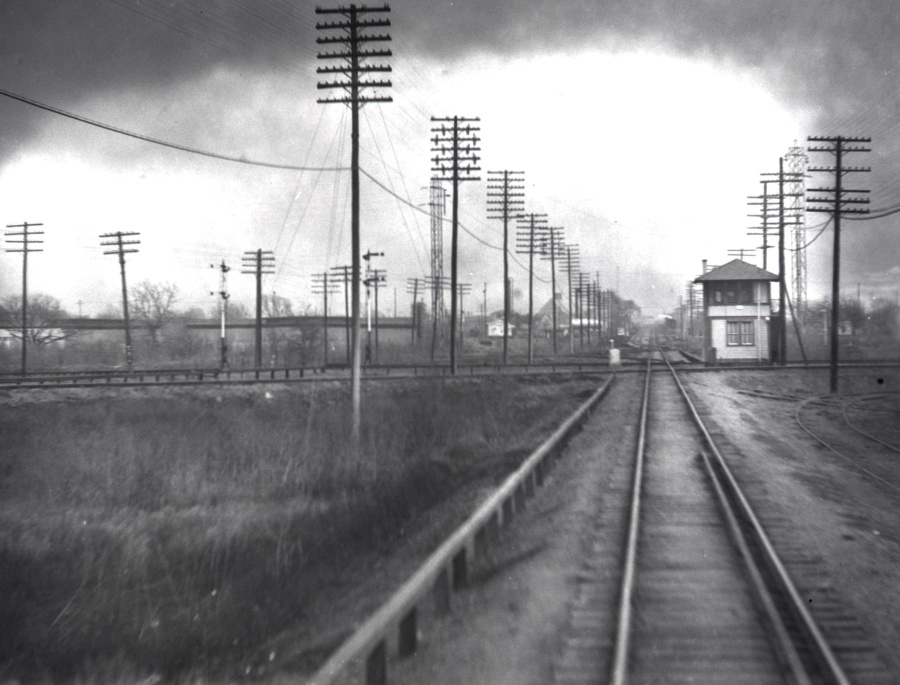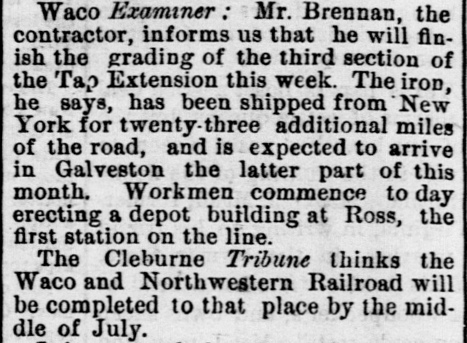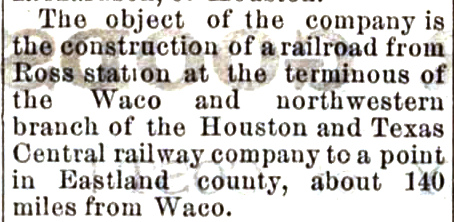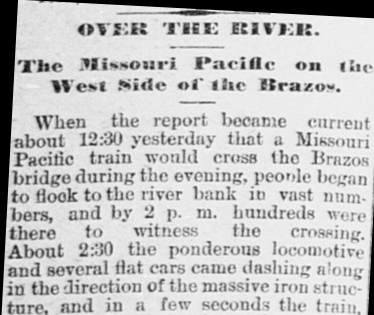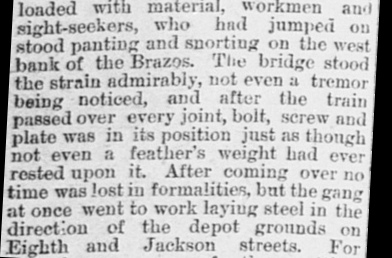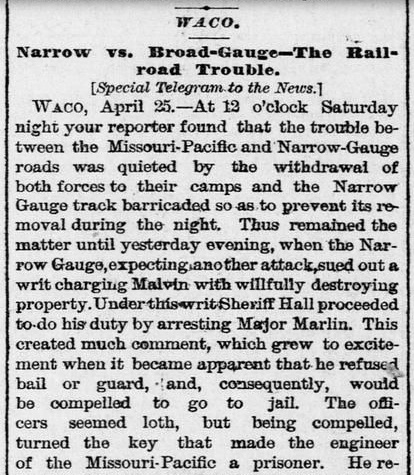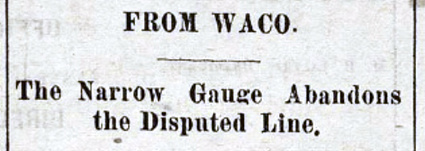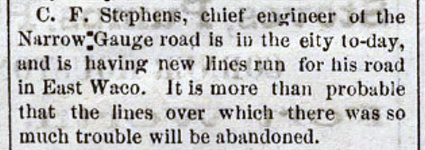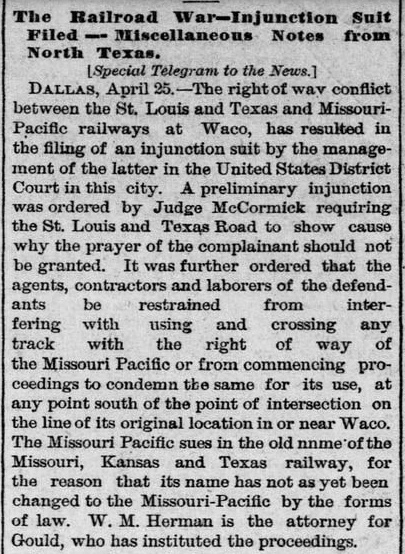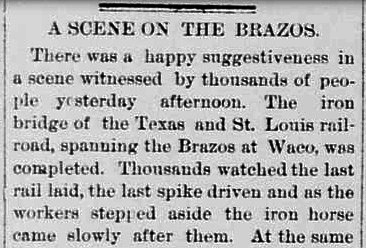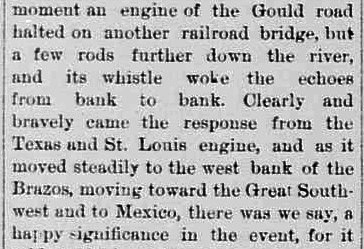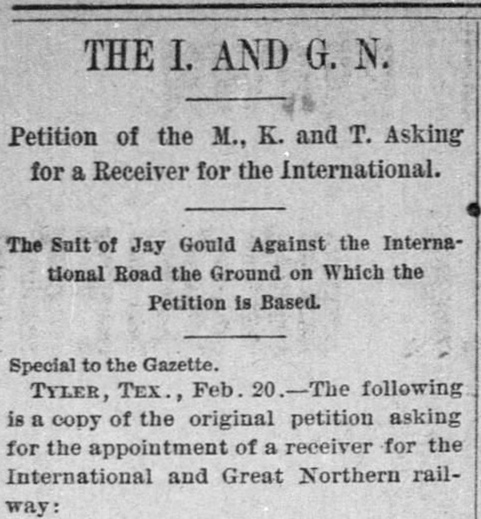As the H&TC had entered receivership in 1885, the
closely related TC suffered the same fate. Its northwest extension to Albany had been completed in 1881, but
construction of the northeastern
branch out of Ennis was still in progress between
Kaufman and Greenville
when the receivership began. The northeastern branch was divested by the
bankruptcy court and sold to Hetty Green in 1892 in exchange for her disclaiming
any financial interest in the TC bonds she held as one of its founding
investors. The branch became the Texas Midland Railroad
to be run by her son Ned. Operating the new railroad may have been enough
for the Greens; despite winning (and then not winning) the first W&NW auction, they did not participate in the second.
In January, 1893, the
TC's reorganization resulted in the
remaining line from Ross to
Albany being deeded by the TC's bondholders to a new Texas Central Railroad Company,
completely independent of the H&TC. The financial restructuring of the TC
had caused it to miss the first W&NW auction, but on sound financial footing, the TC
opened the bidding at the second auction. It wanted direct
access to the other railroads at Waco rather than remaining limited to the W&NW
connection at Ross.
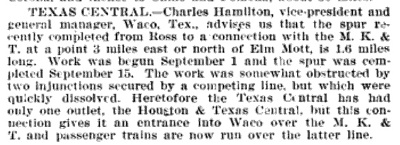 |
Failing to win the auction, the TC instead
built a 1.6 mile spur from Ross to the Katy main line three miles north of Elm Mott, as reported (left)
on Sept. 24, 1897 by Railway Age. The
H&TC
had sued, but was unable to stop it. [This ROW is probably Ross Rd. today.] No longer getting much business at Ross,
SP leased
their Ross - Waco line to the TC, as reported (right)
by
Railway and Engineering Review, August 5, 1899. The TC built its own line from Ross to Waco
in 1903. |
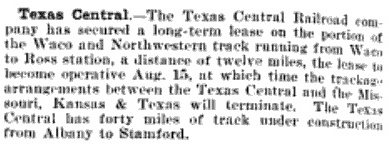 |
The TC added
tracks from Albany to Stamford (1900), Stamford to Rotan (1907) and De Leon to
Cross Plains (1911.) In 1910, the Katy -- independent for two decades -- acquired 90% of the stock of
the TC. It did not, however, take control of the company until May 1, 1914
when the TC was leased to the Katy's Texas-based subsidiary.
In 1895, the Katy finally completed the line from Fort Worth to Houston
through Waco that
Gould had begun building south from Denison in 1881. This
provided yet another competitor in the valuable Fort Worth - Houston market besides SP
and Santa Fe. George Gould was President of both the
I&GN and the T&P, and his T&P was a major force in Fort Worth
railroading. Unfortunately, the T&P and I&GN could only offer a lengthy,
circuitous route between Fort Worth and Houston via Mineola,
Troup and Palestine, service much too slow to capture
a legitimate market share.
Gould began to contemplate a faster, more direct route between Fort
Worth and Houston that could create a competitive advantage. He would do this under the
auspices of the I&GN, with the southern endpoint at Spring, about 25 miles north of Houston on the main line to Palestine. To isolate construction finances, Gould chartered a separate
railroad, the Calvert, Waco and Brazos Valley (CW&BV), but it existed only
on paper and only briefly. The entire line was built in disjointed
sections
by multiple I&GN crews as reflected in the construction reports submitted
annually to the Railroad Commission of Texas (RCT):
1900:
Calvert to Valley Junction, 14.3 miles (CW&BV)
1901: Valley Junction to Bryan, 22.75 miles (CW&BV)
1901: Calvert Junction to Marlin, 28.65 miles
(CW&BV)
1902: Bryan to Spring, 78.22 miles (I&GN)
1902: Marlin to Waco, 41
miles (I&GN)
1903: Waco to Fort Worth, 94.55 miles (I&GN)
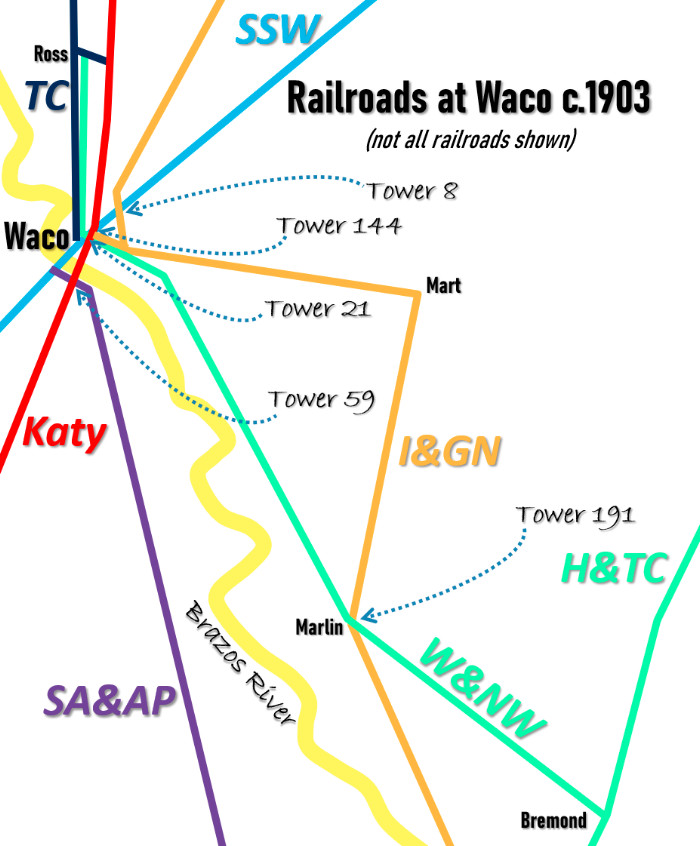 |
In February, 1901, an act
of the Texas Legislature gave formal permission for the I&GN to acquire
and merge the CW&BV. The line had been built east / north of the Brazos
River, paralleling the H&TC (former W&NW) much of the way and crossing
it at Marlin. Because the original W&NW
survey had located the best route between Marlin and Waco, the I&GN
instead turned north at Marlin and went to the town of Mart before
turning west to reach Waco. At Waco, the I&GN built a spur into East
Waco for passenger service while the main line went north along the
eastern outskirts of town, connecting with the Katy and Cotton Belt. The
I&GN also crossed the Cotton Belt about two and a half miles northeast
of the Brazos River. The I&GN arrived at Fort Worth in 1903, but unfortunately for Gould, the line soon became notorious for accidents
attributed to poor signaling and
a poorly constructed roadbed.
In 1902, RCT authorized
construction of Tower 8 to control the I&GN's crossing of the Cotton
Belt east of Waco. RCT had gained this authority under a 1901 state law
directing it to manage the deployment of interlocker technology to improve crossing
safety. This also improved operational efficiencies by limiting
unnecessary stops at grade crossings of two railroads. RCT
commissioned Tower 8 for operation on June 12, 1903 with a 20-function
mechanical interlocking plant. Tower 8's function count was larger than
would be required for a simple interlocked crossing (typically a dozen functions) indicating that there were
connecting tracks at the junction from the outset. At the end of 1904,
RCT's annual report reduced the Tower 8 function count to 16. It remained at this value until it rose to 34 in the report
issued at the end of 1928. The report issued at the end of 1930 (the last
comprehensive interlocker report ever issued by RCT) lowered the count back to
16, suggesting that perhaps the increase to 34 was simply a reporting error or
perhaps a
typesetting mistake.
The I&GN was under constant orders from RCT to correct
various issues and improve service on the Fort Worth line and elsewhere. When the U.S. went into a depression caused by
the Panic
of 1907, the I&GN was unable to make bond payments and it entered
receivership in February, 1908. The receivership lasted three years
under the appointed Receiver, Judge Thomas Freeman, a former T&P
attorney. Freeman rehabilitated much of the I&GN's roadbed and signaling systems using $11 million in short term Receiver Certificates
authorized for sale by the Court. In June, 1911, the Gould family bought
the I&GN out of bankruptcy and named Judge Freeman to be the new
President. Yet, revenues were insufficient to retire the short term
notes issued during the receivership, hence the I&GN went
back into bankruptcy in 1914. At that point, the Gould family connection to the
I&GN ended forever. It was not until July 28, 1922 that the I&GN emerged from
bankruptcy as a newly reorganized and independent company under the name International -
Great Northern Railroad (hence both I&GN and I-GN are
used as abbreviations.)
Left:
area overview; Towers 59, 144 and 191 were installed after 1903 |
Though MP had lost its Texas presence when the Katy
lease was cancelled, the Gould family remained in control until a financial
reorganization in 1917 after which MP's Gould era ended completely. In 1924, MP
tried to buy the newly independent I-GN as a means of reentering the Texas
market but the Interstate Commerce Commission (ICC) refused to approve the sale.
To keep the I-GN away from other competitors, MP helped the New Orleans, Texas &
Mexico (NOT&M) Railway buy the I-GN. That sale was approved by the ICC in June,
1924 and six months later, MP was allowed to buy the entire NOT&M on January 1,
1925. This gave MP the target I-GN plus the other assets of the NOT&M, which had
been operating several railroads along the Texas and Louisiana coasts under the marketing name
Gulf Coast Lines. The I-GN continued to operate under its own name
until 1956 when a lengthy MP receivership ended, resulting in the I-GN becoming
fully integrated into the reorganized MP.
The major junction of
all of the railroads near the riverbank in East Waco became the location of Tower 21, authorized by RCT to commence operation
on August 8, 1903. This was where the H&TC (W&NW) line along the east bank of
the Brazos crossed the Katy and Cotton Belt lines. The junction's complexity
explains Tower 21's opening as a 49-function / 44-lever electric interlocker
built by the Taylor Signal Co., the most complex interlocking in
Texas at
the time (eclipsed by the 59 functions of Tower 26
several weeks later.) In its annual report, RCT listed the Katy, the
Cotton Belt and the H&TC as the expense-sharing participants at
Tower 21.
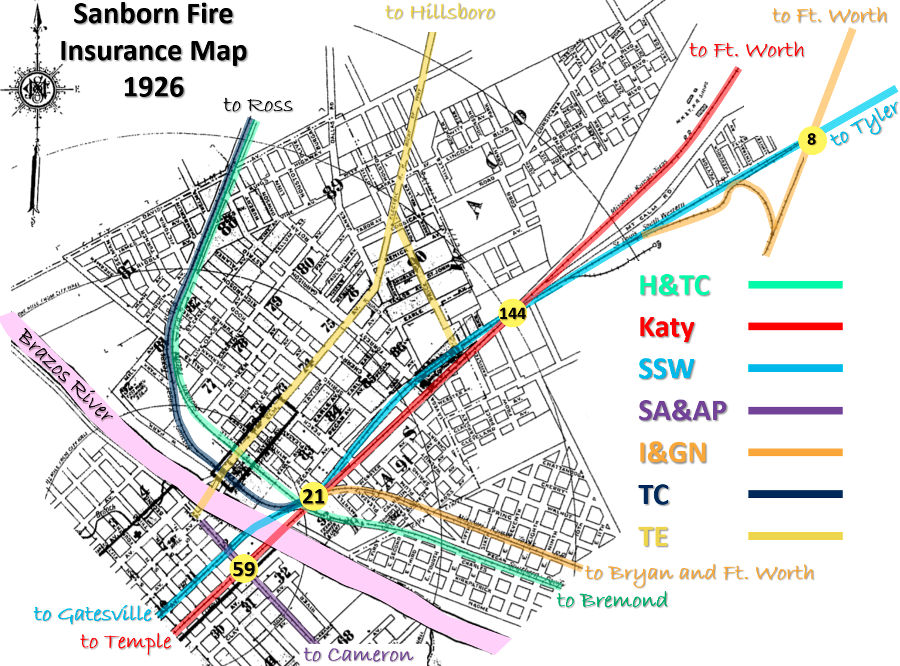 |
Left:
This index for the 1926 Sanborn Fire Insurance Map of Waco
has been annotated to highlight rail lines, interlocking towers and the
Brazos River. Besides
the railroads discussed above, there are two additions that appear on
the map. The San Antonio & Aransas Pass (SA&AP) had entered Waco from
the southeast in the late 1880s and ended downtown near the river. Tower 59
was established in November, 1904 where the SA&AP crossed the Katy,
about 700 ft. south of the Katy's Brazos River bridge. The Texas Electric (TE) was an electric interurban line from Dallas to Waco via
Hillsboro. It had an interchange track with
the Cotton Belt on
Price St. and it crossed the Brazos on its own bridge. The map also shows the H&TC (W&NW) tracks still intact to Ross.
Three years after the map was drawn, SP abandoned the line to Ross. It
had been of limited utility since 1903 when the TC built its own Ross -
Waco line.
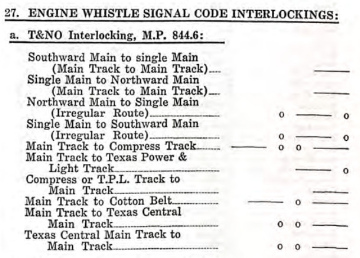
Above: The MKT Employee Timetable
of May 1, 1950 listed the locomotive whistle codes for various Katy and
TC movements at Tower 21. |
In 1916, RCT's annual report began listing the railroad
that operated each tower. Tower 21 had the same architecture as many other Texas
towers built by SP (e.g. 16, 17,
81 and many others), so it was no surprise that SP
subsidiary H&TC had the responsibility for staffing Tower 21. In most cases, the
railroad that designed and built a tower would also take responsibility for staffing
it. The recurring operation and maintenance (O&M) expenses for staffing,
utilities and materials would be shared by
the railroads that used the interlocker, typically on a "weighted function
count" basis (the percentage of an interlocker's total function count
applicable to each railroad.) RCT's interlocker list dated
October 31, 1916 showed an increase in Tower 21's functions to a total of
59. By the end of 1930, Tower 21's function count had reached 67; it was a busy place.
Tower 8 was listed with the Cotton Belt as the railroad responsible for
operations. This is surprising; the crossing did not exist until 1902 or 1903,
placing it after the enactment of the 1901 state law granting powers to RCT to
authorize and approve interlockers. By rule for post-1901 crossings, the second
railroad to arrive (here, the
I&GN) was obligated to pay the entire capital cost of the tower, and in most such
cases, that railroad would lead the design and construction effort. As noted
above, leading the construction effort usually resulted in taking the responsibility for
O&M staffing. The railroad that led Tower 8's
design and construction is not confirmed, but an El
Paso Daily Times news item published February 24, 1903 mentions
installation of the Cotton Belt / I&GN interlocker at East Waco and asserts that the
I&GN's "...Superintendent of Buildings and Bridges is in charge of this work
at the junction..." The railroad in charge of the design can usually be
determined from architectural commonality with other towers, but unfortunately, no photo of Tower 8 has been found.
The railroads were free to negotiate their own arrangments, and for whatever
reasons, the Cotton Belt had accepted the staffing responsibility for Tower 8,
at least as of 1916. It might, however, have been different in earlier years.
For example, assuming the I&GN had the original staffing responsibility, its
receivership in 1908 could have motivated the Cotton Belt to take over the
responsibility if it had concerns about the I&GN's ability to staff the tower and cover the
up front cash flow for O&M expenses.
On May 29, 1928, RCT commissioned an interlocker, Tower
144, to control the crossing of the Katy and the Cotton Belt about a mile
northeast of Tower 21. The Katy referred to this location as Bellmead, an unincorporated community
(at the time) where the Katy had opened shops in the mid 1920s near a
long-standing Cotton Belt yard. The crossing was just south of the south end of
the Cotton Belt yard, and this proximity meant that Cotton Belt trains were always traveling at low speed as they
approached Tower 144 from either direction. In contrast, the Katy had a main
track that bypassed its yard, thus avoiding delays through the yard for
passenger trains. RCT's
list of active interlockers published at the end of 1928 shows the Tower 144
interlocker having only two functions, the smallest
number of functions ever commissioned by RCT for a numbered interlocker. RCT described the interlocking plant as "Mechanical" instead of
"M.-Cabin", which is how most of the others in that timeframe were listed, e.g.
Tower 143 at Devers,
Towers 145 and 149 at Edinburg, and several others. Cabin interlockers had
become common in the late 1920s as RCT required the
railroads to begin installing interlockers at the remaining uncontrolled
crossings that could not otherwise justify the expense of a manned tower. Automatic
interlocker technology had not yet been approved by RCT (see
Towers 141 and 142) so cabin interlockers (operated
by train crews) were the best option.
Tower 144's listing as "Mechanical"
with only two functions suggests that it was probably the first Ground Lever
interlocker approved by RCT (the only other was later, at
West Livingston.) Tower 144 wasn't really an
interlocker at all. It was simply a two-position lever located trackside that
controlled signals and derails instead of a track switch. The lever would
normally be positioned to permit unrestricted movements on the Katy tracks (the
busier of the two) until a Cotton Belt train needed to cross. All Cotton Belt
trains stopped at the crossing and a crewmember would exit the train to throw
the lever to the opposite position to warn any approaching Katy train to stop. A
crewmember would then return the lever to its normal position after the Cotton
Belt train had completed its passage over the diamond. Since the Cotton Belt
yard was a short distance north of Tower 144, its trains were moving at low
speed anyway, hence this procedure contributed a negligible delay to Cotton Belt operations.
Right: This track chart (courtesy of Ed Chambers)
drawn by the Katy Railroad Chief Engineer's Office in 1915 illustrates
why Tower 21 was commissioned with 44 active levers. The Katy, Cotton
Belt, TC, I&GN (passenger lead) and H&TC all converged in East Waco
just north of the river. Note that in addition to connecting to the
Cotton Belt bridge, the H&TC also connects to the Katy bridge at Tower
21. This map dates to seventeen years prior to SP's acquisition of the
Cotton Belt.
The H&TC depot is shown on the line to Ross
near Tower 21 while the Cotton Belt's "Union Station" and the Katy depot
were both in downtown Waco south of the river. Since the I&GN used Union
Station, its passenger lead merges onto the Cotton Belt tracks near
Tower 21.
Tower 144 was commissioned thirteen years after this chart was drawn, but the crossing it controlled had existed
since the early 1880s. Five years after this map was drawn, the Katy
built a major yard
and shops at Bellmead. The "Cut-Off To T.C. M.L." at the top of
the image is not the TC spur between Ross and
Elm Mott. It was a shortcut between the TC main line and the Bellmead yard built after
the Katy had acquired the TC. It remains intact to serve an industry adjacent to
the former TC main line. |
 |

Above:
This note in the July 30, 1944 Cotton Belt Employee Timetable (ETT)
confirms that a "one lever interlocking device" was used to control the
Tower 144 crossing.
Right:
This excerpt from a September, 1956 Katy employee timetable (ETT)
instructs train crews facing a STOP signal at Tower 144 with no apparent
Cotton Belt train approaching the crossing to "...line lever on StLSW to
set derails against StLSW, which will clear signal on M-K-T."
|
 |
In 1965, SP
abandoned the former W&NW tracks between Marlin
and Bremond, and sold the remaining Marlin - Waco track segment to MP. Both railroads had tracks
from Marlin to Waco but SP's route was shorter with fewer curves
and lower grades. MP laid new tracks at Marlin to merge its line from
Valley
Junction into the SP tracks that it now owned. At East Waco, MP rerouted the
SP tracks onto the former I-GN line from Mart that led into MP's yard and
continued north to Fort Worth. From the reroute point, SP's tracks to Tower 21
were abandoned. A short segment of the I-GN line east toward Mart was retained
as a business spur,
but the rest of the line was abandoned through Mart all the way to Marlin.
As MP and SP were negotiating the
sale of SP's Marlin - Waco tracks, they were also looking at sharing SP's tracks
between
Bryan and
Navasota. SP's route between the towns was part of
the original H&TC line dating to the 1860s whereas the corresponding I-GN route
was longer and dated to 1902. MP was able to negotiate rights on SP's line and
proceeded to abandon 27 miles of I-GN tracks between Bryan and Navasota in 1965.
In addition to affecting the interlockings at those two towns, the
Tower 7 interlocking at College Station was no
longer needed.
The following year, MP began preparing to abandon its
former I-GN route between Waco and Fort Worth. To replace it, MP built a short
connecting track to the Katy at Bellmead to access trackage rights it had
negotiated on Katy's line to Fort Worth. The former I-GN route from Waco to the
outskirts of Fort Worth was abandoned in 1967-68. The end result of all of these
transactions was that MP's route southward from Fort Worth to Spring used Katy trackage rights to Waco, former
SP tracks to Marlin, I-GN tracks to Bryan, SP trackage rights
to Navasota, and the original I-GN route from there to Spring. This route
remains in use by Union Pacific (UP), successor to MP.
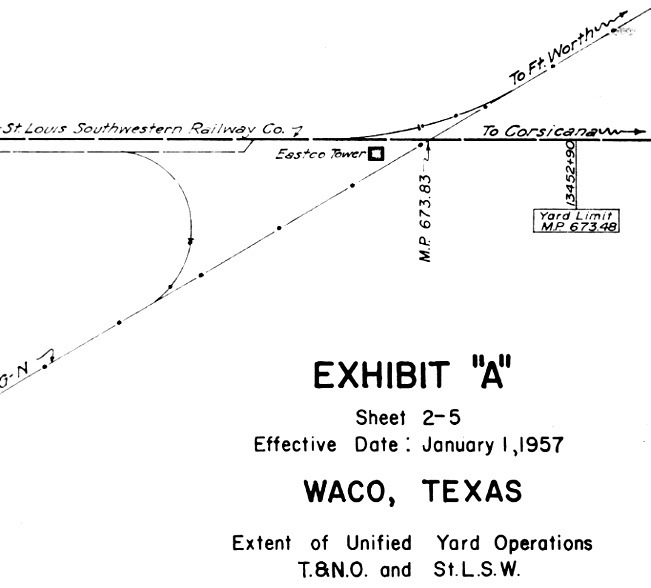
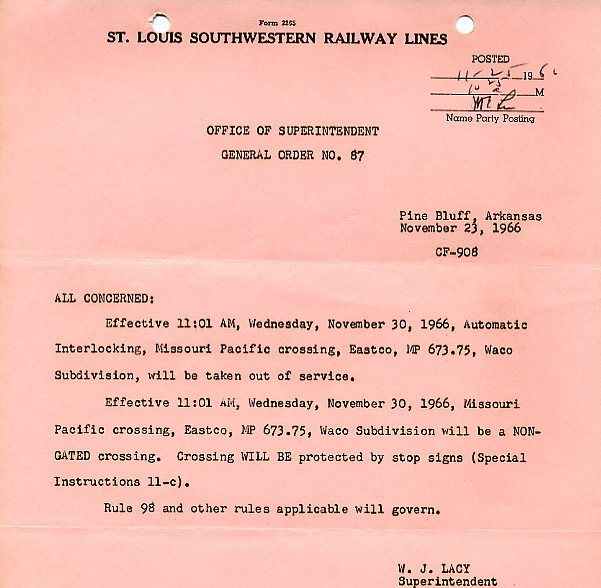
Above Left:
Over the years, Tower 8 became known as "Eastco Tower". The use of that
nomenclature with the rectangle icon on the above "Exhibit A" suggests that it remained a manned tower as
of 1957. It was converted to an automatic interlocker at least by September, 1961
when it is listed as such in a MP ETT. The fate of the tower structure is
undetermined. (Tom Kline collection)
Above Right: On
November 30, 1966, SSW issued this bulletin announcing that the automatic
interlocking at Tower 8 was being taken out of service. The new
Katy / MP (I-GN) connection had become operational allowing MP to exercise Katy
trackage rights between Fort Worth and Waco. Since the tracks remained intact, the
Tower 8 crossing was changed to a Stop sign, but notably, it was "NON-GATED".
Presumably, the lack of a gate reflected MP's intent to stop using the tracks,
but whether it had already obtained ICC permission to terminate service to the
stations on the route to Fort Worth is undetermined. ICC approval was apparently
forthcoming; the former I-GN was abandoned in 1967 (to
Maypearl) and 1968 (to Everman, a suburb of Fort Worth.) The Cotton Belt lasted
another twenty years,
abandoned between Corsicana and Waco (53 miles) in 1988. (Tom Kline collection)
Below Left:
This 1970 image ((c) historicaerials.com) illustrates how MP was able to abandon the I-GN tracks (yellow arrows) north of Waco by building a connection
(orange arrows)
to merge onto the Katy's line to Fort Worth (blue arrows); the switch is off the top of the
image at a location known as MP JCT. The Cotton Belt tracks
(pink arrows) cross the MP at two places: at Tower 8 (green circle) and at the new MP / Katy connector (blue
circle.) As expected, magnification shows that the I-GN tracks through Tower 8 had been
removed by the time this
image was captured. The MP (I-GN) / Cotton Belt connector (red arrow) remained intact.
Below Right: This ETT issued by MP in June, 1971 locates the
revised Cotton Belt crossing (blue circle) at MP's milepost 165.4 with symbols
indicating that it was at grade '(X)'
and controlled by an Automatic Interlocker '(A)'. "Via MKT" indicates
MP's use of 85 miles of Katy trackage rights between MP JCT and FW TOWER (Tower
53.) Further below, the
Cotton Belt ETT from 1985 shows "MP Crossing" (blue circle) at the Cotton Belt's
milepost 674.1 with letters 'AY'
signifying an Automatic interlocking within Yard limits. The Cotton Belt general order above lists Eastco (green circle) at milepost 673.75. The difference of 0.35 miles is the Cotton Belt
timetable distance between the two crossings (the actual distance is shorter,
about 0.22 miles.) This proximity, however, is irrelevant; they were never
operational simultaneously.

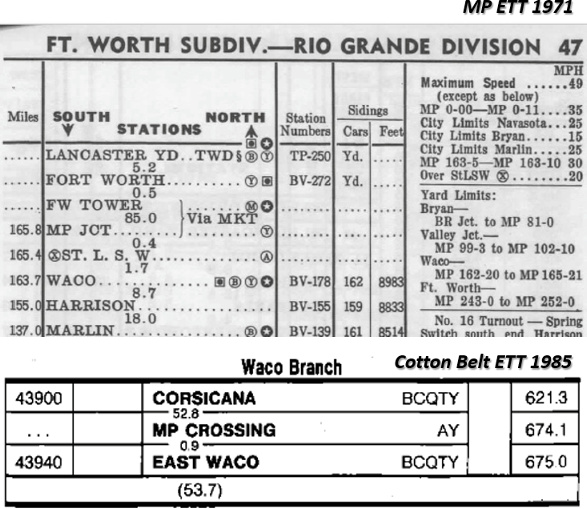
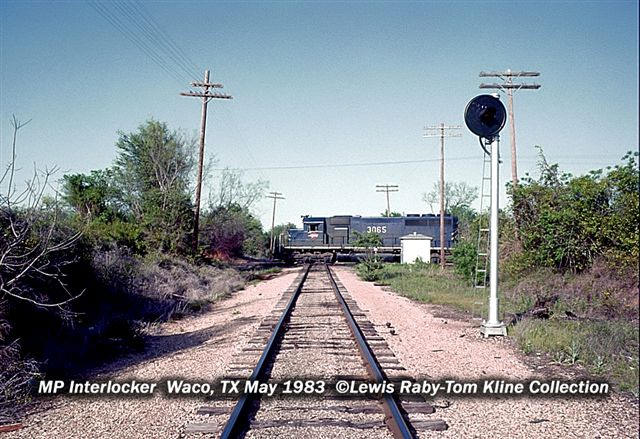

Above Left: In 1983, Lewis
Raby took this photo of northbound MP locomotive #3065 crossing the Cotton Belt
on the the MP / Katy connector. The view is northeast along the Cotton Belt
tracks in the direction of the dormant Tower 8 crossing about a quarter mile
from the camera. The white cabin housed the automatic interlocker, and
to its left, a white post is barely visible where a lock box is mounted to house the manual override controls for the
interlocker. (Tom Kline collection)
Above Right: This 1958 aerial image
((c) historicaerials.com) shows the Tower 8 crossing. The Cotton Belt tracks run
diagonally across the image with the I-GN tracks crossing in the middle on a
slightly more north / south heading. The tower is casting the shadow visible in
the southwest acute angle of the crossing. The source of the shadow visible east
of the I-GN tracks is undetermined. Traces of the connecting track illustrated
on the "Exhibit A" track chart above are visible on the northwest side of the
diamond.
UP acquired MP in 1982, several years before it
purchased the Katy and merged it into MP's operations in 1989. The former Katy main line
through Waco between Ft. Worth and Smithville remains an active route for UP.
The fate of Tower 21 has not been determined, but it was likely removed from
service c.1965 when the SP tracks to the tower were abandoned. A Katy
employee timetable from September, 1965 shows an automatic interlocker
controlling the crossings managed by Tower 21, and the tower building does not
appear on 1970 aerial imagery.
Below: In 1988, the Cotton Belt tracks were abandoned
between Corsicana and East Waco. West of the Brazos, the Cotton Belt to
Gatesville had gradually been cut back to the vicinity of
McGregor, and in 1989, the tracks to McGregor were
abandoned from the west outskirts of Waco. SP continued to serve existing
customers located on its remaining trackage in Waco by sharing MP's Brazos River
bridge and the MP line from East Waco through Valley Junction to Hearne, where
SP had a yard. In 1996, UP acquired SP and fully merged it (along with MP) in
1997. The Cotton Belt bridge over the Brazos remains intact but was longer used
after the 1988-89 abandonments. The debate over whether to preserve it (and for what purpose) or dismantle
it continues. (Waco Tribune-Herald photos)

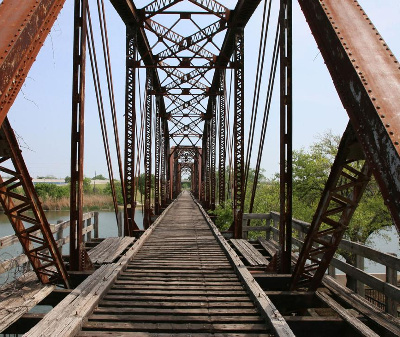
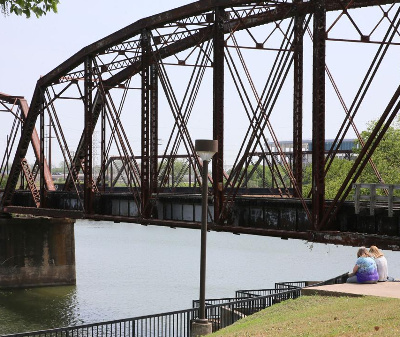
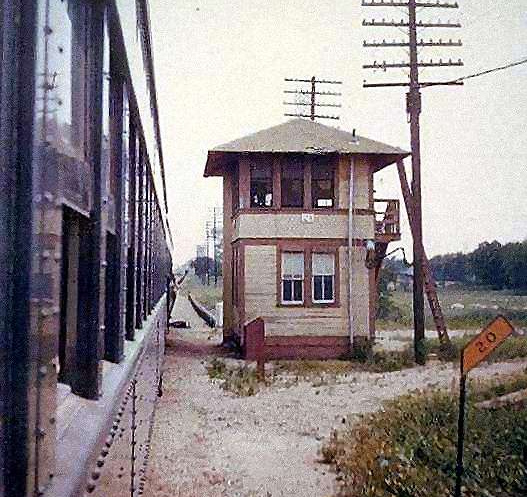
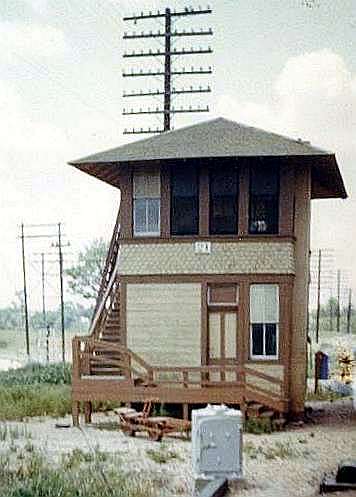
|
These photos of Tower 21 (by Harry C. Blaize Jr., from the collection of John Linda) were taken from a train carrying
model railroaders from the Katy's Waco depot to the Bellmead Shops in 1954.
Far Left: the south
side of Tower 21; Near Left:
the north side of Tower 21 |
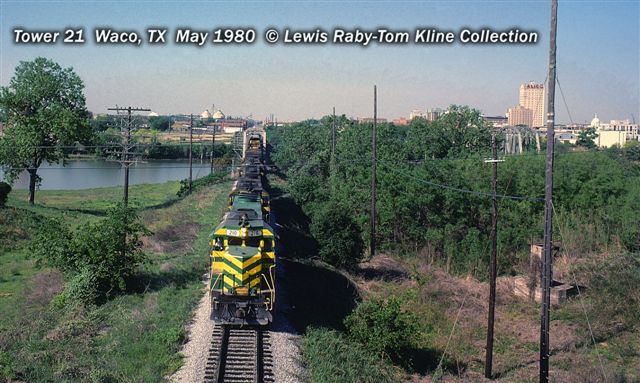
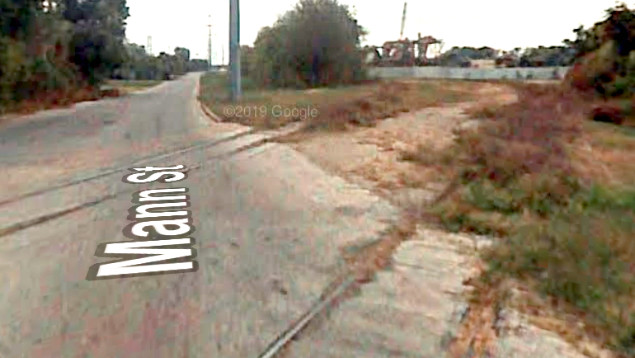
Above Left: This 1980 Lewis
Raby photo shows a northbound Katy train coming off the Brazos River bridge near the
former site of Tower 21. Note the
truss of the Cotton Belt bridge visible beyond the trees at right. (Tom
Kline collection) Above Right:
This Google Street View image from December, 2007 facing east on Mann St. shows
that parallel tracks of the W&NW (SP, left) and TC (Katy, right) to Ross
still had rails buried in the pavement despite abandonment by their owners in
1929 and 1967, respectively. In both cases, rails had remained in place in Waco
to support local businesses. Both sets of tracks appear to have been out of
service by 2007, and the rails had all been removed by the date of the next
Google Street View in December, 2012.
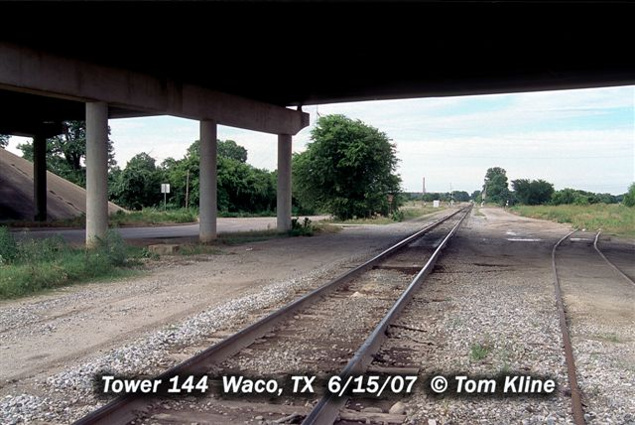
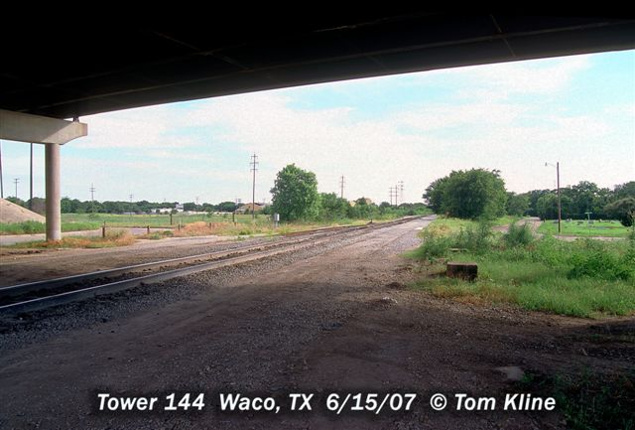
Above Left: Tom Kline captured
this image of the Tower 144 crossing site in 2007. Facing north along the Katy, the
Cotton Belt tracks still came in from the northeast but are out of service and
no longer cross. Tom has documentation showing that at least by 1957, Cotton Belt
trains were merging here onto the Katy main line and then rejoining the Cotton
Belt tracks to the bridge at Tower 21. The rails
west of Tower 144 became industry tracks.
Above Right: In this view to the south, concrete pads remained intact from earlier signal
posts. The Cotton Belt ROW went through the tree line to the right of the Katy
tracks. Below Left:
By March 2013, Google Street View shows that the Cotton Belt tracks had been
scrapped. Some sort of electronics box remained intact, and is visible in Tom's
photo above right. Below Right:
There's not much evidence of the former Tower 144 crossing, which now sits
beneath a US 77 Bus. overpass. Both Cottonbelt St. and Katy Lane
are nearby. (Google Earth)
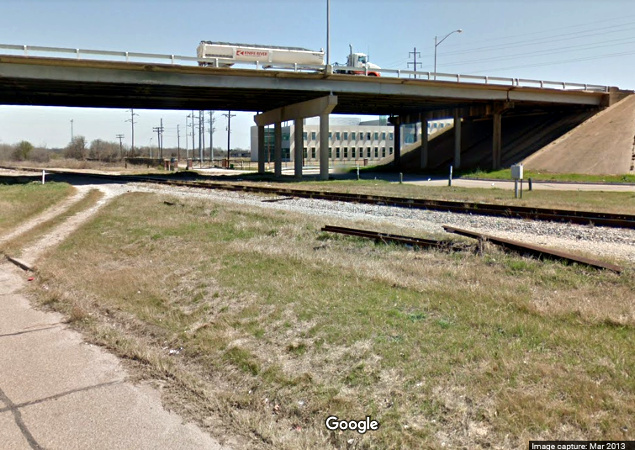
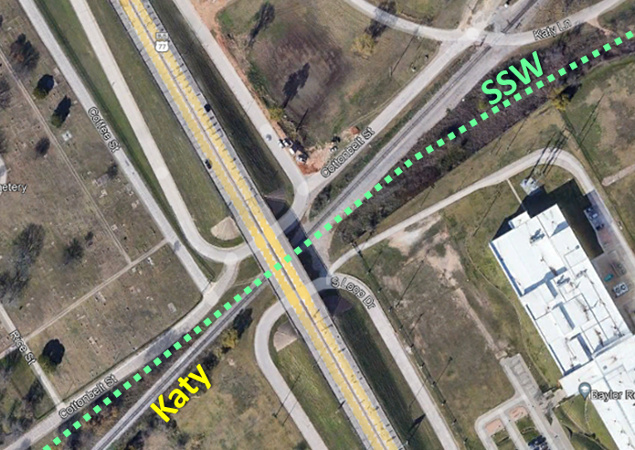
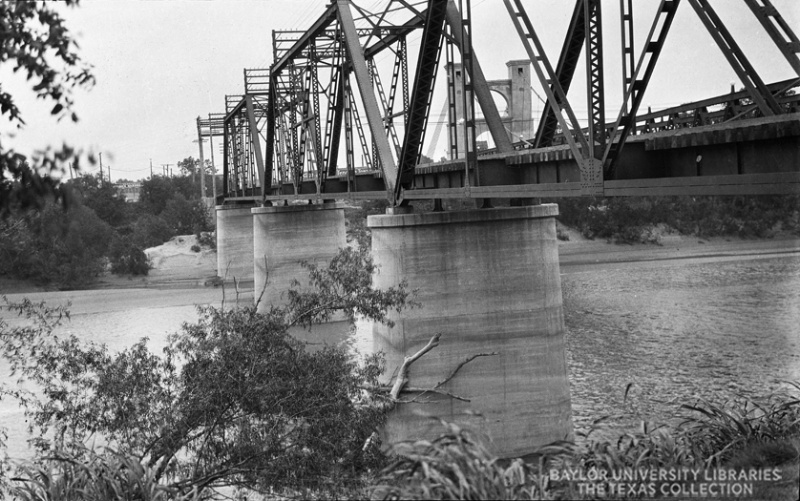
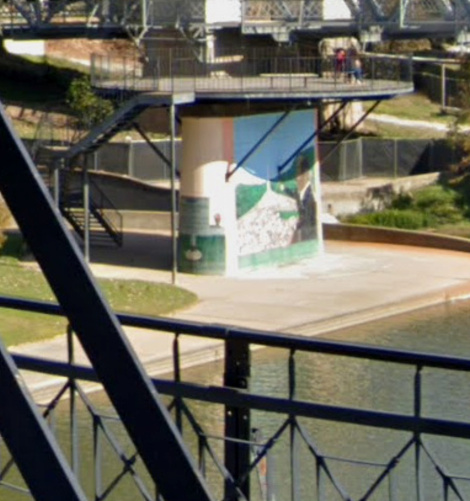
As annotated onto the
Sanborn Map further above, there was one other
railroad through East Waco, an electric interurban line built originally by the
Southern Traction Co. that was completed into Waco in 1913. The Texas Electric (TE)
Railway was then chartered in 1916 to merge the Southern Traction Co. and the
Texas Traction Co., creating a network of three interurban routes out of Dallas
that ran to Waco, Corsicana and Sherman, respectively. The TE line from Dallas
to Waco went by way of Italy and
Hillsboro. At Waco, the
interurban had an interchange track with the Cotton Belt railroad on Price St. and then
continued south to cross the Brazos River into downtown on a 3-pier rail bridge
(above left, looking north,
date unknown, courtesy Baylor University Library.) The bridge was located about 350 yards
upstream of the Cotton Belt bridge. The TE terminated its operations at the end
of 1948 and the interurban bridge was re-decked to carry automobiles. The
opening of the Franklin Ave. bridge in 1973 motivated the decision to dismantle
the interurban bridge. This began in the summer of 1974 and was completed in
September, 1975, but the bridge's three piers were left undisturbed in the
river. The northernmost pier has been painted and repurposed (above
right) to hold a circular observation deck. (Google Street View,
November, 2021.)
Below: The
two piers that remain in the river along with the circular observation deck
built atop the northernmost pier sit adjacent to the
Waco Suspension Bridge. (Google Earth, October 30, 2019)
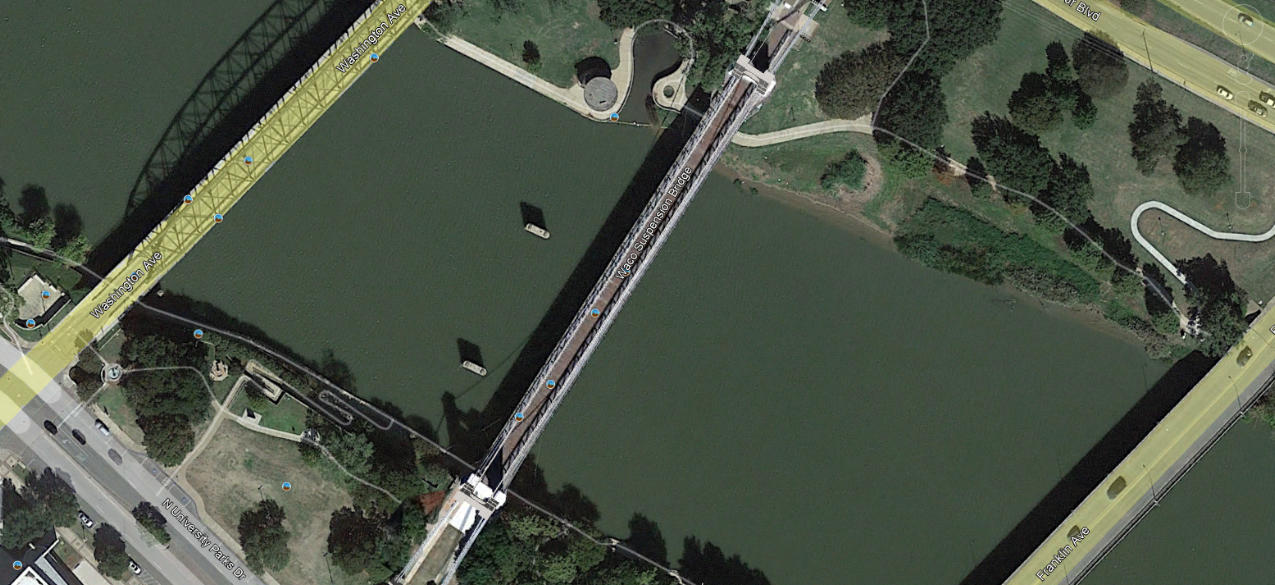
Thanks to Andy Nold, John
Linda and Johnny Myers for information about the interurban line into Waco.

